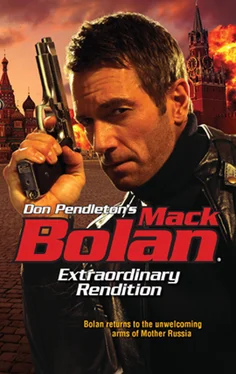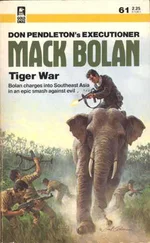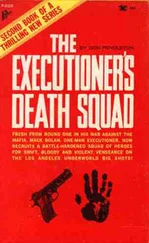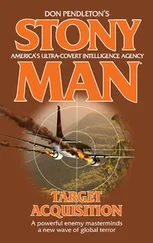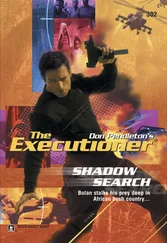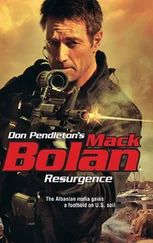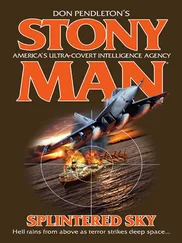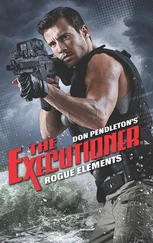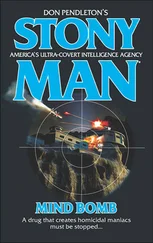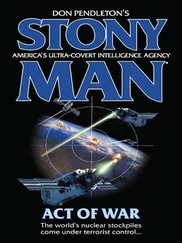Before the man she knew as Cooper cleared another thirty yards, Pilkin counted five men trailing him. They might have passed unnoticed in the flow of passengers, airport employees and assorted idlers, if she hadn’t been well trained and they had been more skillful.
Enemies came in all shapes, sizes and colors. Some were natural chameleons, while others stood out for their bearing, brutish looks, or quirks that give away their secrets. These five shared a common arrogance most often seen in the associates of the Russian Mafiya—and all of them were talking to themselves in turn, revealing to an educated watcher that they kept in touch by means of tiny two-way radios.
And they were armed. The bulges visible beneath some of their jackets told Pilkin that, and she assumed the ones whose weapons weren’t evident had simply dressed themselves more carefully. They passed a few militia officers along the way, but were ignored.
So much for tight airport security.
Anzhela Pilkin had a choice to make.
She could keep following her contact and his shadows, wait until they made a move and try to intervene, or she could leave the terminal and fetch her car. Be ready when he needed her.
The second course of action took some faith.
She had to trust that the mobsters were smart enough to bide their time and seek a place with fewer witnesses before they made a move. And she had to trust her contact to remain alive for several minutes on his own, away from Pilkin’s observant eyes.
She made her choice, broke off pursuit and started walking swiftly—nearly running—to the closest exit from the airport terminal.
WITH NO SIGN of his contact, Bolan had a choice to make. His basic options were to wait inside the airport terminal or leave it, but both choices had their built-in risks.
Waiting meant somehow dealing with the watchers who were trailing him. He’d counted three, but couldn’t tip his hand by dawdling along and sneaking peeks for any others who had joined them. Three was bad enough, with Bolan presently unarmed. A confrontation in the terminal would draw police, and that would be the end of his mission, whether he survived or not.
Leaving the terminal posed different risks. He could obtain a rental car with no great difficulty, but his shadows would most likely make their move when he went to collect it in some nearby parking lot or garage. Bolan assumed that some of them, at least, were armed. Whether their orders were to kill him on the spot or bring him out alive, when he resisted, one or more of them might snap.
And if he managed to survive that showdown, even take their weapons for himself, then what? He’d be adrift in Moscow, with its thirteen million people and no way of reaching his contact.
Who might or might not even be alive.
Bolan couldn’t approach the U.S. Embassy, since he was traveling as a Canadian. It wouldn’t help to reach the CIA’s station chief, since the Company had been frozen out of his mission. He had contacts, but only for potential “cleanup” jobs. Forget the Canadian consulate, too. Even if they agreed to send him “home,” his mission would have failed.
On the flip side, he couldn’t drop by FSB headquarters in Lubyanka Square and spill his story to a desk sergeant, either. The Russian side was worried about leaks of their own, keeping a tight lid on the operation. It was strictly need-to-know, or so he’d been informed, although the men now stalking him were living evidence that someone had to have spilled the beans.
The good news was that if he managed to clear the airport alive, he knew enough about his target to reach the man’s last known address. Bolan supposed that he could arm himself in Moscow, with an estimated 170,000 illegal guns in circulation, but what of it?
His mission didn’t call for an assassination. He’d been sent to find, extract and deliver one man to a team that would put him on ice and presumably ship him off somewhere for trial.
That end of it was not Bolan’s concern. But he’d been told, with heavy emphasis, that Washington required this guy alive. His showcase trial, apparently, was more important than the man himself or any of his crimes.
A message to the predators: no matter where you hide, you are within our reach.
As if they’d care and somehow magically reform.
Unless Bolan could bag his man and summon the extraction unit, none of that was happening.
He made his choice, passed by the car-rental kiosks and kept going, toward the nearest exit from the terminal. He would choose his ground, confront his enemies and see what happened next.
Outside, the sun was going down. The late afternoon was warm and humid, making Bolan’s shirt stick to his skin. Across six lanes of airport traffic, opposite his exit door, stood a tall parking garage. Hired cars were picked up and returned on the ground floor. The rest, Bolan supposed, was rented by the space to travelers or those on hand to meet them.
It would be as good a battleground as any.
He had one foot off the curb when a little gray sportster squealed to a stop in front of him, its right-front fender nearly grazing his shoe.
Behind the wheel, the face he had been watching for since his arrival snapped at him, “Get in, will you, while you still can!”
Washington, D.C., two days earlier
The International Spy Museum was located at 800 F Street Northwest, one block east of Ford’s Theater and one block north of FBI Headquarters, directly opposite the Smithsonian American Art Museum and the National Portrait Gallery. It occupied five buildings, renovated at a cost of forty million dollars, and had earned its keep with interest since it opened in July 2002.
The museum had no parking lot of its own, so Bolan left his rental in a commercial garage two blocks over and walked back, still early, enjoying the sunshine. Spring was being kind to Washington, so far.
He doubted that it would be kind to him.
Only a few museums in Washington charged entrance fees. The Spy Museum was one of them, collecting twenty dollars from adults and shaving off a buck for active-duty members of the military. Entry through a “controlled” checkpoint included receipt of cover profiles for each visitor, with instructions to memorize the details in five minutes flat. Fledgling spies received a simple “mission,” but weren’t required to complete it. Staff “police” stopped visitors at random, grilling them for details of their cover, adding just a hint of spice. For true enthusiasts, the interactive Operation Spy pavilion offered simulations that included detection and disarming of a nuclear device.
Bolan went through the motions and moved on, idling past some of the museum’s six hundred exhibits depicting the evolution of espionage from ancient Greece and Rome to the twenty-first century. At any other time, it would have piqued his interest, but he had a real-life mission of his own.
Or would have, very shortly.
Keeping an eye on the time, Bolan drifted toward the museum’s Spy City Café, a snack shop for guests whose budgets wouldn’t cover dining at the adjacent, upscale Zola Restaurant. He wasn’t hungry, but he planned on meeting someone there.
And his contact, as always, was punctual.
“The fish is red,” Hal Brognola said as he sidled up to Bolan.
“Guess I’ll have the chicken, then,” Bolan replied.
Brognola frowned and said, “That’s not the counter-sign.”
“Sorry. I must’ve missed the memo.”
“Jeez. You kids today.”
“If I’m a kid, that makes you—what? A yuppie?”
“God forbid. Let’s take a walk.”
They walked.
“I thought this place would suit us,” the big Fed remarked. “With everybody hyped on spies and role-playing, we ought to fit right in.”
Читать дальше
